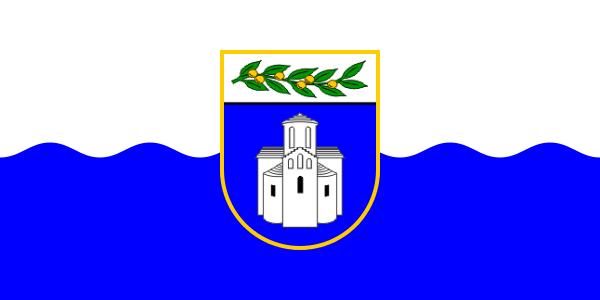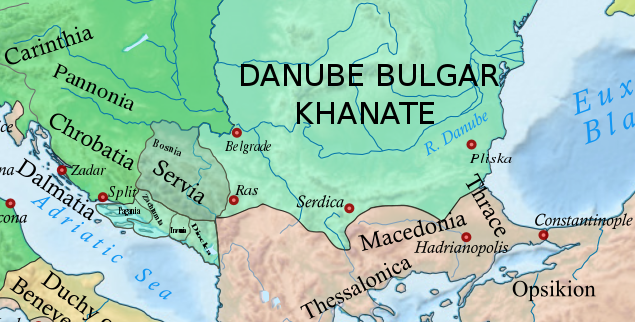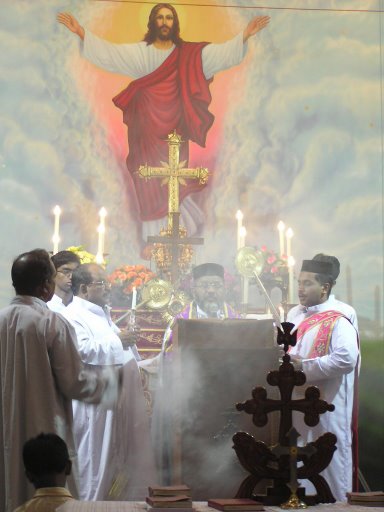|
Duke Branimir
Branimir () was Duke of Croatia, reigning from 879 to 892. His country received papal recognition as a state from Pope John VIII on 7 June 879. During his reign, Duchy of Croatia retained its sovereignty from both Carolingian and Byzantine rule and became ''de jure'' independent.Stjepan Antoljak, Pregled hrvatske povijesti, Split 1993., str. 43. His rule marks the first real peak of early medieval Croatia. It was characterized by establishing closer relations with the Holy See, ecclestical re-organization in the former Roman province of Dalmatia, Christianization, and (re)construction of churches. Branimir is mentioned, for the period, in many reliable primary and secondary written and epigraphic sources. Reign Rise to power In 879, a "certain Slav of the name Branimir" reportedly had the weak Duke Zdeslav, a supporter of the Byzantine Empire, killed near Knin in a rebellion that he led, per John the Deacon's '' Chronicon Venetum et Gradense'' (early 11th century). Five pap ... [...More Info...] [...Related Items...] OR: [Wikipedia] [Google] [Baidu] |
Nin, Croatia
Nin (; , or ''Nona'') is a town in the Zadar County of Croatia. Nin was historically important as a centre of a medieval Christian Diocese of Nin. Nin was also the seat of the Princes of Dalmatia. Geography Nin's historical center is located on an islet only 500 meters (yards) in diameter. Nin is situated in a lagoon on the eastern shore of the Adriatic Sea, surrounded by natural sandy beaches and linked with the mainland by two stone bridges from the 16th century. History According to historians the area of Nin appears to have been settled 10,000 years ago. The present-day town on the islet developed 3,000 years ago and is one of the older towns on the eastern Adriatic. The area of Nin was first colonized by immemorial people of the Mediterranean. Since the 9th century B.C. the civilization of the Illyrian tribe of Liburnians was present before the Romans came, who had a strong sea and trade center called Aenona (this morphed in the Middle Ages into Nona). The rich ar ... [...More Info...] [...Related Items...] OR: [Wikipedia] [Google] [Baidu] |
Byzantine Empire
The Byzantine Empire, also known as the Eastern Roman Empire, was the continuation of the Roman Empire centred on Constantinople during late antiquity and the Middle Ages. Having survived History of the Roman Empire, the events that caused the fall of the Western Roman Empire in the 5th centuryAD, it endured until the fall of Constantinople to the Ottoman Empire in 1453. The term 'Byzantine Empire' was coined only after its demise; its citizens used the term 'Roman Empire' and called themselves 'Romans'. During the early centuries of the Roman Empire, the western provinces were Romanization (cultural), Latinised, but the eastern parts kept their Hellenistic culture. Constantine the Great, Constantine I () legalised Christianity and moved the capital to Constantinople. Theodosius I, Theodosius I () made Christianity the state religion and Greek gradually replaced Latin for official use. The empire adopted a defensive strategy and, throughout its remaining history, expe ... [...More Info...] [...Related Items...] OR: [Wikipedia] [Google] [Baidu] |
Adriatic Sea
The Adriatic Sea () is a body of water separating the Italian Peninsula from the Balkans, Balkan Peninsula. The Adriatic is the northernmost arm of the Mediterranean Sea, extending from the Strait of Otranto (where it connects to the Ionian Sea) to the northwest and the Po Valley. The countries with coasts on the Adriatic are Albania, Bosnia and Herzegovina, Croatia, Italy, Montenegro, and Slovenia. The Adriatic contains more than 1,300 islands, mostly located along its eastern coast. It is divided into three basins, the northern being the shallowest and the southern being the deepest, with a maximum depth of . The prevailing currents flow counterclockwise from the Strait of Otranto. Tidal movements in the Adriatic are slight, although acqua alta, larger amplitudes occur occasionally. The Adriatic's salinity is lower than the Mediterranean's because it collects a third of the fresh water flowing into the Mediterranean, acting as a dilution basin. The surface water temperatures ... [...More Info...] [...Related Items...] OR: [Wikipedia] [Google] [Baidu] |
Narentines
The Narentines were a South Slavic tribe noted as pirates on the Adriatic Sea in the 9th and 10th centuries. They occupied an area of southern Dalmatia centered at the river Neretva (). Named ''Narentani'' in Venetian sources, they were called ''Paganoi'', "pagans", by the Greeks, as they were still pagan after the Christianization of the neighbouring tribes. They were fierce enemies of the Republic of Venice, attacking Venetian merchants and clergy traveling through the Adriatic, and even raiding close to Venice itself and defeating the doge several times. Venetian–Narentine peace treaties did not last long, as the Narentines quickly returned to piracy. They were finally defeated in a Venetian crackdown at the turn of the 10th century and disappeared from sources by the 11th century. Terminology The word ''Narentine'' is a demonym derived from the local Neretva River (). The terms "Narentines", "Pagania" or "Pagans" are found in two contemporary sources: ''De Administrando I ... [...More Info...] [...Related Items...] OR: [Wikipedia] [Google] [Baidu] |
Republic Of Venice
The Republic of Venice, officially the Most Serene Republic of Venice and traditionally known as La Serenissima, was a sovereign state and Maritime republics, maritime republic with its capital in Venice. Founded, according to tradition, in 697 by Paolo Lucio Anafesto, over the course of its History of the Republic of Venice, 1,100 years of history it established itself as one of the major European commercial and naval powers. Initially extended in the ''Dogado'' area (a territory currently comparable to the Metropolitan City of Venice), during its history it annexed a large part of Northeast Italy, Istria, Dalmatia, the coasts of present-day Montenegro and Albania as well as numerous islands in the Adriatic Sea, Adriatic and eastern Ionian Sea, Ionian seas. At the height of its expansion, between the 13th and 16th centuries, it also governed Crete, Cyprus, the Peloponnese, a number of List of islands of Greece, Greek islands, as well as several cities and ports in the eastern Me ... [...More Info...] [...Related Items...] OR: [Wikipedia] [Google] [Baidu] |
Charles The Fat
Charles the Fat (839 – 13 January 888) was the emperor of the Carolingian Empire from 881 to 887. A member of the Carolingian dynasty, Charles was the youngest son of Louis the German and Hemma, and a great-grandson of Charlemagne. He was the last Carolingian emperor of legitimate birth and the last to rule a united kingdom of the Franks. Over his lifetime, Charles became ruler of the various kingdoms of Charlemagne's former empire. Granted lordship over Alamannia in 876, following the division of East Francia, he succeeded to the Italian throne upon the abdication of his older brother Carloman of Bavaria who had been incapacitated by a stroke. Crowned emperor in 881 by Pope John VIII, his succession to the territories of his brother Louis the Younger ( Saxony and Bavaria) the following year reunited the kingdom of East Francia. Upon the death of his cousin Carloman II in 884, he inherited all of West Francia, thus reuniting the entire Carolingian Empire. Usually con ... [...More Info...] [...Related Items...] OR: [Wikipedia] [Google] [Baidu] |
Rome
Rome (Italian language, Italian and , ) is the capital city and most populated (municipality) of Italy. It is also the administrative centre of the Lazio Regions of Italy, region and of the Metropolitan City of Rome. A special named with 2,746,984 residents in , Rome is the list of cities in the European Union by population within city limits, third most populous city in the European Union by population within city limits. The Metropolitan City of Rome Capital, with a population of 4,223,885 residents, is the most populous metropolitan cities of Italy, metropolitan city in Italy. Rome metropolitan area, Its metropolitan area is the third-most populous within Italy. Rome is located in the central-western portion of the Italian Peninsula, within Lazio (Latium), along the shores of the Tiber Valley. Vatican City (the smallest country in the world and headquarters of the worldwide Catholic Church under the governance of the Holy See) is an independent country inside the city boun ... [...More Info...] [...Related Items...] OR: [Wikipedia] [Google] [Baidu] |
Feast Of The Ascension
The Feast of the Ascension of Jesus Christ (also called the Solemnity of the Ascension of the Lord, Ascension Day, Ascension Thursday, or sometimes Holy Thursday) commemorates the Christian belief of the bodily Ascension of Jesus into Heaven. It is one of the ecumenical (shared by multiple Christian denomination, denominations) feasts of Christian churches, ranking with the feasts of the Passion (Christianity), Passion and Pentecost. Following the account of that the risen Jesus appeared for 40 days prior to his Ascension, Ascension Day is traditionally celebrated on a Thursday, the fortieth day of Easter according to inclusive counting, although some Christian denominations have moved the observance to the following Sunday, sometimes called Ascension Sunday. The day of observance varies by ecclesiastical province in many Christian denominations, as with Lutherans and Catholics, for example. Ascensiontide refers to the ten-day period between the Feast of the Ascension and the Fe ... [...More Info...] [...Related Items...] OR: [Wikipedia] [Google] [Baidu] |
Chronicon Venetum Et Gradense
The ''Chronicon Venetum et Gradense'', formerly known as the ''Chronicon Sagornini'', is a Venetian chronicle compiled by John the Deacon in ca. 1008. It is the oldest chronicle of the Republic of Venice. John was the chaplain and perhaps a relative of Venetian Doge Pietro II Orseolo Pietro II Orseolo (961−1009) was the Doge of Venice from 991 to 1009, and a member of the House of Orseolo. He began the period of eastern expansion of Venice that lasted for the better part of 500 years. He secured his influence in the Dalma ... (r. 991–1009). The first part, dealing with early history, is lacking, only later becoming more accurate, and in the time of John himself deemed particularly valuable. It details the reign of Pietro II. References Sources *{{cite book, last=Herbermann, first=Charles George, title=The Catholic Encyclopedia, url=https://books.google.com/books?id=R1HTvhNblQUC, year=1950, publisher=Appleton, page=491 1008 works Medieval historical texts in Latin C ... [...More Info...] [...Related Items...] OR: [Wikipedia] [Google] [Baidu] |
John The Deacon (Venetian Chronicler)
John the Deacon ( or ''Giovanni da Venezia''; 940–45 – died after 1018) was a Venetian deacon, secretary to the doge of Venice and a chronicler. The Venetian chronicle According to the Catholic Encyclopedia (1913): The oldest chronicle of Venice, known as the '' Chronicon Sagornini'', was compiled by deacon John, the chaplain and perhaps a relative of the Doge Pietro II Orseolo (991–1009). John enjoyed the confidence of this doge, and was often sent as his ambassador to Holy Roman Emperors Otto III and Henry II. In the first part of his chronicle, which deals with the early period of the republic, the narrative is often confused and deficient; later it becomes more accurate and complete, and for the time in which the writer himself lived it is particularly valuable. He carries the narrative to 1008 and treats in detail of the reign of Pietro Orseolo. John's chronicle is a key primary source for the history of Slavic peoples and polities in Dalmatia during the 9th and 10th ... [...More Info...] [...Related Items...] OR: [Wikipedia] [Google] [Baidu] |
Miroslav Krleža Lexicographical Institute
Miroslav may refer to: * Miroslav (given name), a Slavic masculine given name * ''Young America'' (clipper) or ''Miroslav'', an Austrian clipper ship in the Transatlantic case oil trade * Miroslav (Znojmo District), a town in the Czech Republic See also * * Miroslava (other) Miroslava may refer to: * Miroslava (given name), list of people with the name * ''Miroslava'' (film), a 1993 film about Miroslava Stern * ''Miroslava'' (fly), a genus in family Scathophagidae * Miroslava, Iași, a commune in Iaşi County, Rom ... * Mirosław (other) {{disambiguation ... [...More Info...] [...Related Items...] OR: [Wikipedia] [Google] [Baidu] |
Croatian Biographical Lexicon
''Croatian Biographical Lexicon'' () is a multi-volume biographical and bibliographical encyclopedia in Croatian, published by the Miroslav Krleža Institute of Lexicography. It contains biographies of prominent Croats, as well as foreigners who participated in Croatian public life and have left their mark on the history of Croatia Croatia, officially the Republic of Croatia, is a country in Central Europe, Central and Southeast Europe, on the coast of the Adriatic Sea. It borders Slovenia to the northwest, Hungary to the northeast, Serbia to the east, Bosnia and Herze .... The project was launched in the second half of the 1970s. Seven volumes have been published so far with a total of 10,218 articles (3,524 illustrations). The editor-in-chief of the first volume was Nikica Kolumbić, of the second volume Aleksandar Stipčević, and since 1990 the chief editor has been Trpimir Macan. Many of the biographies in the lexicon have been researched and published for the ... [...More Info...] [...Related Items...] OR: [Wikipedia] [Google] [Baidu] |






